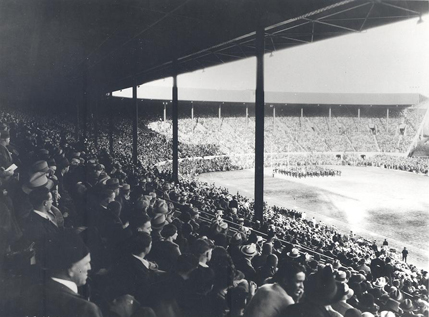Vaughn Street Park, as most Portlanders called it, was built in 1901 by streetcar-line owners C.F. Swigert and E.I. Fuller. The park, which filled an area north of Vaughn Street roughly between 24th and 25th Avenues, provided a home diamond for professional baseball in Portland until 1955. Built and rebuilt over the decades, the largest version of the ballpark seated about 12,000 fans.
Sometimes called Recreation Park, a name that never really caught on, and occasionally described as Lucky Beaver Park, the field hosted its first professional game on the May 22, 1901. A local newspaper reported that the Portland weather was “suitable for a frolic of healthy ducks,” and the Portland entry for the Northwest League that year was the Webfoots. Led by a quiet, cleanup-hitting third baseman from Kansas named Joe Tinker, the team topped the league from opening day through the end of the season. Tinker moved to both second base and the Chicago Cubs the following year and went on to become a Hall of Famer.
In 1903, the Portland franchise left the Northwest League for the upstart Pacific Coast League, renaming the team the Browns. The Browns suffered from numerous injuries and fared poorly their first season in the PCL, but games drew enough fans for the team to remain in business.
Vaughn Street Park remained the home of the Portland PCL franchise, the nickname of which changed several times before it settled on the Portland Beavers, until the mid-1950s. Throughout its service, the small dimensions and high outfield walls of the park—331 feet to left, 368 straightaway, and 315 down the right field line—made it a hitter-friendly stadium. Rocky Benevento worked as groundskeeper at the field from 1927 until its closure in 1955.
The Beavers won the Pacific Coast League title four out of five years, beginning in 1910. In the midst of that run, grandstands paralleling the baselines added significantly to the seating capacity of the park, doubling it from 6,000 to 12,000. Success for the franchise came less regularly after that.
The venue may have enjoyed its heyday during the early 1940s, when it drew workers from nearby shipyards. Jim Thorpe, Ted Williams, and Joe DiMaggio all played games for their respective teams at the park. Fans at Vaughn Street also witnessed Satchel Paige in his later years, as well as the Rosebuds, Portland’s own entry into the short-lived West Coast Negro Baseball League. Olympic champion Jessie Owens owned the Rosebuds, and prior to one game, in hopes of drawing better crowds, he raced a horse along a stretch of foul territory.
By the summer of 1946, when the Rosebuds briefly shared the field with the Beavers, the facility at Vaughn Street Park had degraded to the point where the fire marshal issued a report that it was a fire hazard and suggested that new grounds be found for the team. His assessment proved prescient, as the left-field grandstands burned the following year.
The 1955 Beavers season was the last played at Vaughn Street Park. The next year, the team moved south to Multnomah Stadium (later called Civic Stadium, PGE Park, and, beginning in 2011, Jeld-Wen Field). The ballpark was torn down the following year, and the site was converted to industrial purposes.
-
![]()
Vaughn Street Park.
Courtesy Oregon Hist. Soc. Research Lib., OrHi85018
-
![]()
Portland Beavers vs. San Francisco Seals game at Vaughn Street Park, 1943.
Oregon Historical Society Research Library, Digital Collections, Al Monner news negatives; Org. Lot 1284; Box 20; 810-1 -
![]()
Vaughn Street Park.
Courtesy Oregon Hist. Soc. Research Lib., OrHi54896
-
![]()
Portland Beavers at Vaughn Street grounds, 1941.
Oregon Historical Society Research Library, Digital Collections, Al Monner news negatives; Org. Lot 1284; Box 12: 317-7 -
![]()
Baseball field at Vaughn Street park, 1941.
Oregon Historical Society Research Library, Digital Collections, Al Monner news negatives; Org. Lot 1284; Box 12; 317-2
Related Entries
-
![Multnomah Stadium]()
Multnomah Stadium
Multnomah Stadium—also known as Civic Stadium, Portland General Electri…
-
![Portland Beavers (baseball team)]()
Portland Beavers (baseball team)
The Portland Beavers represented Portland in minor league baseball for …
Map This on the Oregon History WayFinder
The Oregon History Wayfinder is an interactive map that identifies significant places, people, and events in Oregon history.
Further Reading
Carlson, Kip, and Paul Andresen. The Portland Beavers. Mount Pleasant, S.C.: Arcadia Publishing, 2004.
Zingg, Paul J. and Mark D. Medeiros. Runs, Hits and an Era: The Pacific Coast League 1903-1958. Champaign: University of Illinois Press, 1994.










